Growing Drummond annual phloxes from seeds: planting and care
As a rule, everyone knows phlox as perennial herbaceous plants... Moreover, paniculate phloxes are most often found. However, now the one-year-old variety - Phlox Drummond is gaining more and more popularity.
Further, you can learn better about the specifics of sowing and growing annual phlox from seeds, the timing of sowing for seedlings and further rules for growing it at home, as well as after planting in open ground on a flower bed.
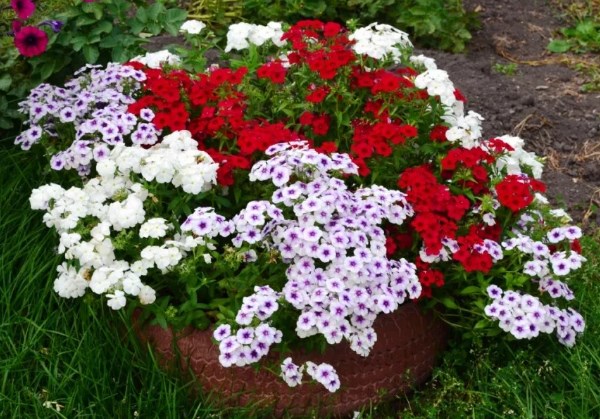
Content
Varieties and varieties of annual Phlox
The only representative of the annual culture is Phlox Drummond, which is so called by the name of the British botanist who brought this plant from America to old Europe.
Naturally, there can be a great variety of varieties of annual phlox (there are both with ordinary inflorescences and with double ones).

When and how to plant annual phlox seedlings
Landing dates
Sowing of annual phlox for seedlings is carried out, as a rule, in March-April, to be planted in the ground in the second half of May (relevant for the Middle Lane).
By the way! Drummond's annual phlox seeds can be sown directly outdoors in April-May if you live in the south or have a very warm spring.
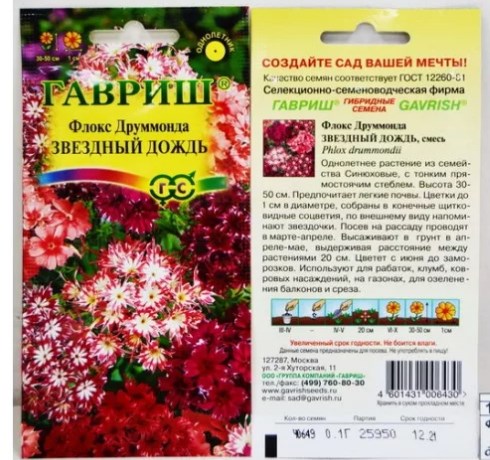
The choice of planting capacity and soil
As for the planting tank, the most important thing when choosing it is that you can make drainage holes in it. Whether it will be a food container or special plastic cassettes for seedlings - it doesn't matter anymore.
Advice! It is very convenient to make drainage holes with a soldering iron or a nail (preheated).
The earth is suitable for the most common and universal for seedling flowers, but it is advisable to supplement it with one of the baking powder, for example, sand, vermiculite or perlite, and also, if desired, add a little wood ash.
By the way! To loosen the soil, you can include in it coconut substrate in a ratio of 1 to 1, or even sow it immediately, because for the normal development of seedlings, the soil mixture must be light and loose (moisture and air permeable).
It would also be correct to preliminarily disinfect the soil (especially if you are using a vegetable garden).
Sowing seeds
Step-by-step instructions for sowing seeds of annual phlox for seedlings:
- Fill the container with soil, but not completely, but about 3/4 (that is, so that 1.5-2 centimeters remain to the top of the container). Level well.
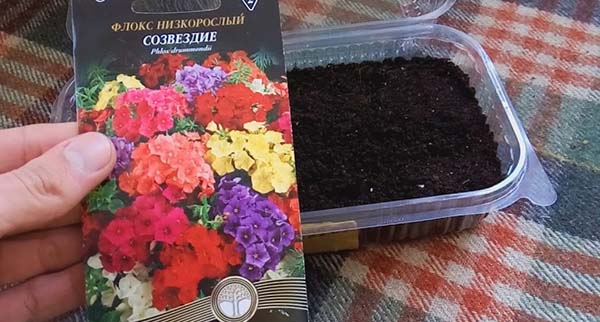
- Now you need to make grooves at a distance of 3-4 centimeters from each other.
- Moisten the soil by spilling it with warm room water, or even better with a solution Fitosporin (for its disinfection).
- Spread the seeds evenly along the grooves.
Planting should not be thickened. Therefore, in order for the seeds to be better seen, you can first pour sand into the grooves and sow on it.
- Further, if desired, you can moisten the crops with a solution of one of the growth stimulants (Epin or Zircon) for more active seed germination.
- Sprinkle the top lightly (literally a couple of millimeters) with the same soil mixture (you can just sand).
By the way! And some gardeners, on the contrary, do not recommend sprinkling, but sowing extremely superficially.
- It is very easy to moisten the topsoil with a spray bottle (if sowing superficially, then this is no longer necessary).
- Close with a lid or cover with plastic wrap (to create a greenhouse effect - warm and humid).
- Place the container in a warm and bright place, where the temperature is around +20 .. + 25 degrees.
Video: sowing seeds of annual phlox for seedlings
Care of phlox seedlings after germination
Every day in the morning, it is advisable to ventilate the landing containers and remove condensate that has collected overnight from the shelter.
The first friendly shoots of phlox appear in about 5-7 days.

Now all care for phlox seedlings will consist of watering as the soil dries up and maintains optimal temperature (+ 18-22 degrees) and daylight (either the sunniest window sill, or supplementary lighting with phytolamps - up to 12 hours).
Like any other seedlings, phlox should not be poured. Although, if you sowed them in light soil, made drainage holes, then this should not happen.
Picking
Phlox seedlings dive when they have 2-4 true leaves.
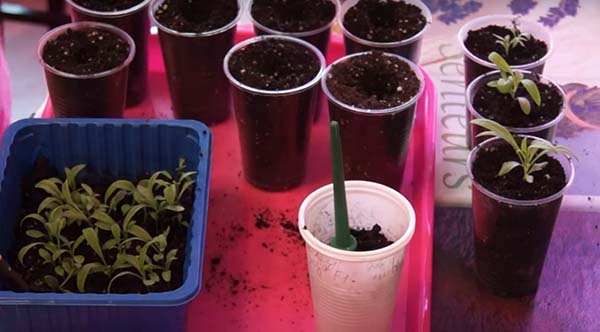
Picking phlox seedlings does not differ from picking any other crops (tomato, peppers, eggplant or petunias):
- take individual containers in which you pre-make drainage holes;
- fill them with a soil mixture (preferably more nutritious, for example, with the addition of humus and wood ash);
- then spill water (preferably with a solution Fitosporin);
- make small holes;
- take out phlox seedlings from a common container with any tool convenient for you;
By the way! Do not forget to spill the container with the seedlings before diving so that the seedlings are easy to reach and their roots are not injured.
- deepen to the cotyledon leaves in cups;
- after transplanting, pour water along the edge, trying not to get on the plant itself.
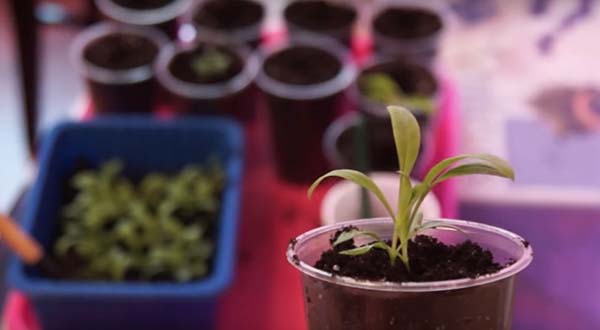
Advice! Immediately after picking, hold the seedlings on a table or in some other place (so that direct sunlight does not fall on it) at least until the end of the day, without exposing it to a light windowsill.
Leaving after a dive includes moderate watering and feedingas well as pinching.
Advice! If you want to achieve better tillering (branching), then pinch over 2-3 pairs of leaves.
As for dressings, it is convenient to use complete mineral fertilizers such as Fertika Lux (powder) or Fertika "Crystal for garden flowers" (liquid solution). The first feeding should be done 10-14 days after the pick. Before planting in the ground, you can repeat 1-2 times (with an interval of 7-10 days).
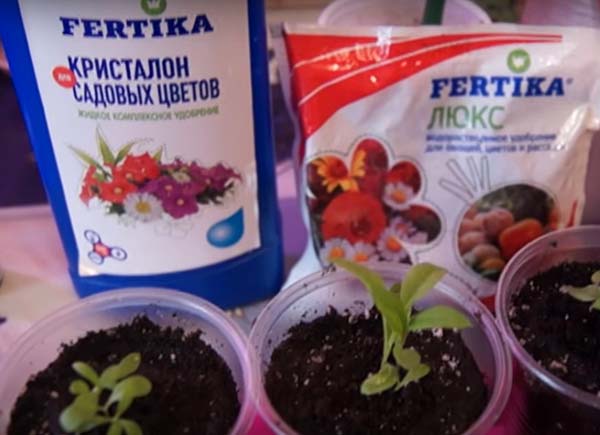
Video: growing seedlings of annual phlox Drummond
Planting seedlings and caring for annual phlox in the open field
The optimal time for planting phlox seedlings in open ground comes when the spring return frosts finally pass. That is, this is approximately the second half of May-early June, depending on the region of your residence and its climatic features.
Annuals, like perennials, do not grow badly in well-lit areas and in partial shade. But it is still better to plant them in some shade (for example, near a fence).
It is optimal to plant phlox seedlings at a distance of 15-20 cm from each other.
Drummond's phlox grows well in fertile and well-drained soil, which means it will be useful to add humus or compost to the ground, as well as wood ash.
Advice! So that the earth retains moisture better and you can water less often, immediately after planting, you need to mulch phlox with peat or humus.

As for the use of annual phlox in the landscape design of your summer house, a place near the rabatka, borders is perfect. It is very beautiful to plant these flowers on rocky hills.
And annual phlox are suitable for growing in garden pots (baskets) or balcony boxes.
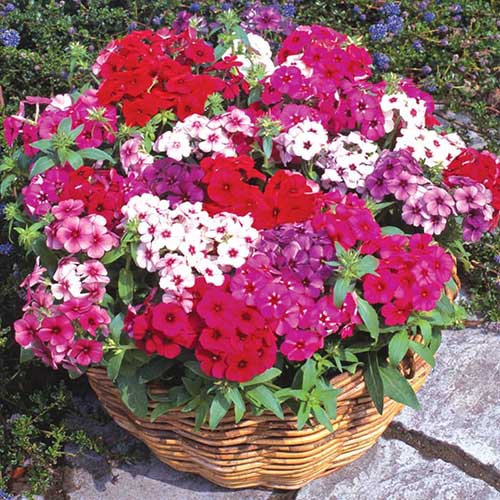
The following garden manipulations must be included in the care of Drummond phloxes:
- active watering in dry weather;
- loosening and weeding from grass and weeds;
- feeding.
During the flowering period (from the end of June to October, i.e. before frost), annual phloxes respond well to fertilizing with potassium-phosphorus fertilizers (more potassium). For example, you can spill solution wood ash (a lot of potassium, a little phosphorus and no nitrogen at all) or use nitroammophos (nitrogen, potassium and phosphorus - 16% each).
Grow seedlings of annual phloxes so that this bright annual will decorate your summer cottage. Good luck!
By the way! It is believed that annual phloxes are very reproduce well by natural self-seeding... However, you can also plant perennial phloxes (again by seeds).

